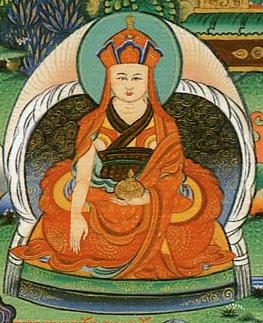Penor Rinpoche Incarnation Line: Difference between revisions
Jump to navigation
Jump to search
No edit summary |
mNo edit summary |
||
| (6 intermediate revisions by 2 users not shown) | |||
| Line 1: | Line 1: | ||
[[Image:Drupwang Pema Norbu.JPG|frame|'''Drubwang Pema Norbu''']] | [[Image:Drupwang Pema Norbu.JPG|frame|'''The First Drubwang Pema Norbu''']] | ||
===Previous Incarnations=== | ===Previous Incarnations=== | ||
*[[Vajrapani]] | *[[Vajrapani]] | ||
*the famous minister of [[King Songtsen Gampo]] called Lönpo Gar Dampa | *the famous minister of [[King Songtsen Gampo]] called Lönpo Gar Dampa | ||
*the son of [[King Trisong Detsen]], Prince Lhasé Damdzin | *the son of [[King Trisong Detsen]], Prince [[Lhasé Damdzin]] | ||
*[[Lhalung Palgyi Dorje]], one of [[Padmasambhava]]'s [[twenty-five disciples]] | *[[Lhalung Palgyi Dorje]], one of [[Padmasambhava]]'s [[twenty-five disciples]] | ||
*Tertön [[Sangye Lingpa]], discoverer of the huge [[Lama Gongdü]] terma cycle | *Tertön [[Sangye Lingpa]], discoverer of the huge [[Lama Gongdü]] terma cycle | ||
===The Drubwang<ref>Drubwang means ' | ===The Drubwang<ref>Drubwang means 'powerful master of accomplishment' or 'lord of [[siddha]]s'.</ref> Pema Norbu<ref>Penor is the contraction of the first two syllables of 'Pema Norbu'. [[Pema]] means 'lotus' and norbu means 'jewel'. </ref> Incarnations=== | ||
*the [[ | *the [[First Drubwang Pema Norbu]] (1679-1757) | ||
*the [[ | *the [[Second Drubwang Pema Norbu]] (1887-1932)<ref>[[Khenpo Ngakchung]] adds | ||
*the [[Penor Rinpoche| | *the First [[Dodrupchen Jikmé Trinlé Özer|Dodrupchen Kunzang Shenpen]] and | ||
*the Second [[Dodrupchen Jikmé Puntsok Jungné]] | |||
to Penor Rinpoche's incarnations in between the first and second Pema Norbus.</ref> | |||
*the [[Penor Rinpoche|Third Drubwang Pema Norbu]] (1932-2009) | |||
All three successive incarnations are counted among the [[throneholders of Palyul Monastery]]. | All three successive incarnations are counted among the [[throneholders of Palyul Monastery]]. | ||
The present day Penor Rinpoche writes: | The present day Penor Rinpoche writes: | ||
::It is not uncommon for there to be a lengthy span of time between the death of a master and the appearance of his or her subsequent reincarnation. My own tulku lineage is an example of this. There was a 130 years hiatus between the death of the First Pema Norbu in 1757 and the birth of the Second Pema Norbu in 1887. This is common in all the traditions of Tibetan Buddhism. As for how these gaps come about, while tulkus are understood to have vowed to be continually reborn to help beings, it is not necessary for them to take rebirth in a continuous sequence of lives in this world. It is believed that they can be reborn in other world systems where they continue their compassionate activities, returning only later to this world system. This is how such lapses in tulku lineages are understood in Tibet. | ::It is not uncommon for there to be a lengthy span of time between the death of a master and the appearance of his or her subsequent reincarnation. My own [[tulku]] lineage is an example of this. There was a 130 years hiatus between the death of the First Pema Norbu in 1757 and the birth of the Second Pema Norbu in 1887. This is common in all the traditions of Tibetan Buddhism. As for how these gaps come about, while tulkus are understood to have vowed to be continually reborn to help beings, it is not necessary for them to take rebirth in a continuous sequence of lives in this world. It is believed that they can be reborn in other world systems where they continue their compassionate activities, returning only later to this world system. This is how such lapses in tulku lineages are understood in Tibet. | ||
===Notes=== | ===Notes=== | ||
<references/> | <small><references/></small> | ||
[[Category:Incarnation Lines]] | [[Category:Incarnation Lines]] | ||
Latest revision as of 12:36, 6 September 2009

Previous Incarnations
- Vajrapani
- the famous minister of King Songtsen Gampo called Lönpo Gar Dampa
- the son of King Trisong Detsen, Prince Lhasé Damdzin
- Lhalung Palgyi Dorje, one of Padmasambhava's twenty-five disciples
- Tertön Sangye Lingpa, discoverer of the huge Lama Gongdü terma cycle
The Drubwang[1] Pema Norbu[2] Incarnations
- the First Drubwang Pema Norbu (1679-1757)
- the Second Drubwang Pema Norbu (1887-1932)[3]
- the Third Drubwang Pema Norbu (1932-2009)
All three successive incarnations are counted among the throneholders of Palyul Monastery.
The present day Penor Rinpoche writes:
- It is not uncommon for there to be a lengthy span of time between the death of a master and the appearance of his or her subsequent reincarnation. My own tulku lineage is an example of this. There was a 130 years hiatus between the death of the First Pema Norbu in 1757 and the birth of the Second Pema Norbu in 1887. This is common in all the traditions of Tibetan Buddhism. As for how these gaps come about, while tulkus are understood to have vowed to be continually reborn to help beings, it is not necessary for them to take rebirth in a continuous sequence of lives in this world. It is believed that they can be reborn in other world systems where they continue their compassionate activities, returning only later to this world system. This is how such lapses in tulku lineages are understood in Tibet.
Notes
- ↑ Drubwang means 'powerful master of accomplishment' or 'lord of siddhas'.
- ↑ Penor is the contraction of the first two syllables of 'Pema Norbu'. Pema means 'lotus' and norbu means 'jewel'.
- ↑ Khenpo Ngakchung adds
- the First Dodrupchen Kunzang Shenpen and
- the Second Dodrupchen Jikmé Puntsok Jungné